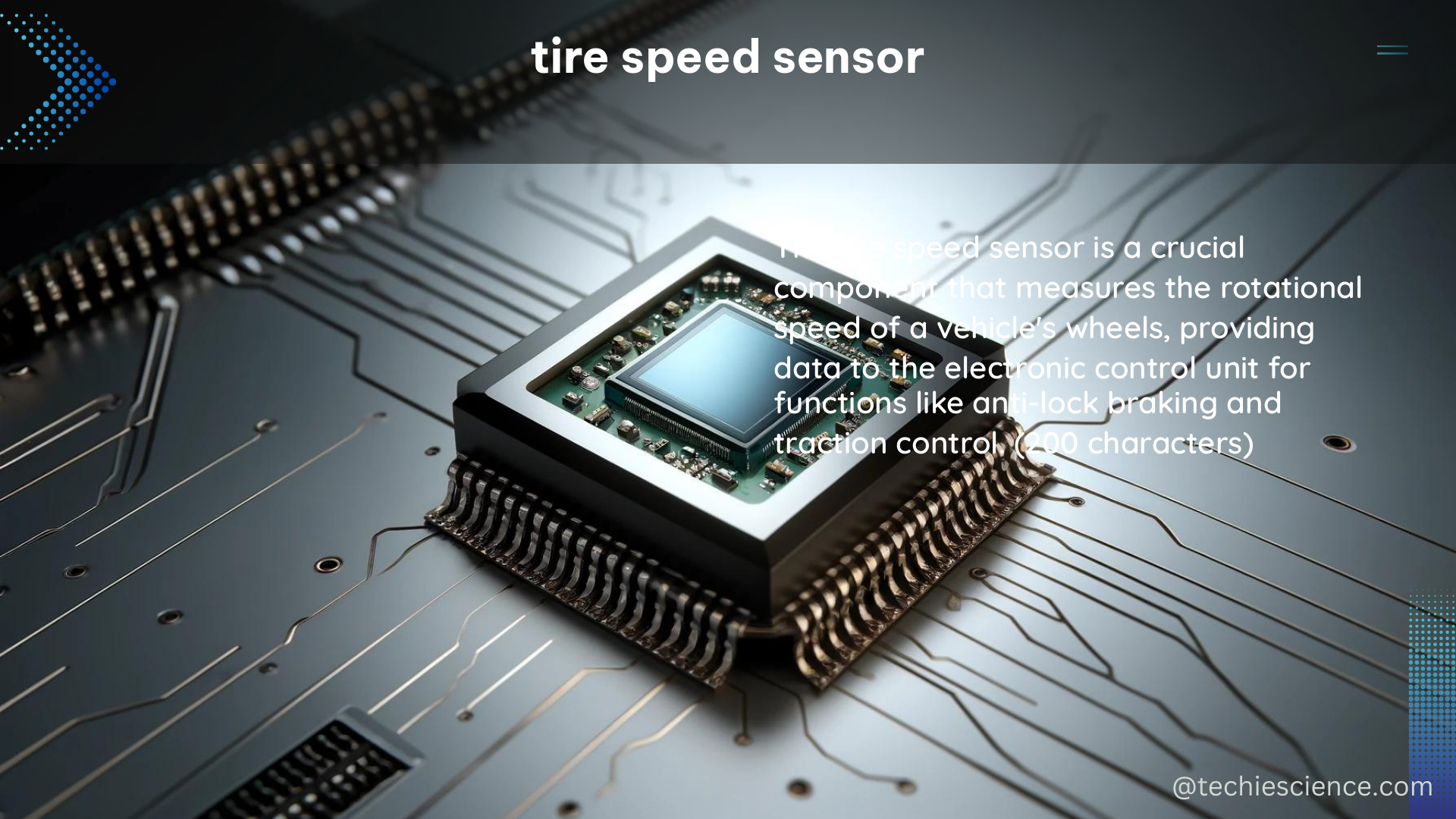Tire speed sensors, also known as wheel speed sensors, are essential components in modern vehicles that measure the rotational speed of the wheels. These sensors play a crucial role in various vehicle safety systems, such as anti-lock braking systems (ABS), traction control, and electronic stability control. Understanding the technical specifications and operation principles of tire speed sensors is crucial for proper diagnosis and maintenance.
Types of Tire Speed Sensors
Tire speed sensors are classified into two main types: passive and active.
Passive Tire Speed Sensors
Passive tire speed sensors generate a usable signal without an additional supply voltage. These sensors are positioned directly adjacent to a toothed impulse or tone ring, which is connected to the wheel hub or driveshaft. The sensor comprises a pole pin surrounded by a winding and connected to a permanent magnet. The magnetic effect produced by the magnet extends to the tone ring. As the tone ring rotates, its alternating teeth spacing passes near the sensor, causing a change in the magnetic field. This change induces an alternating voltage in the sensor winding, and the frequency and amplitude of this voltage change in direct relation to the wheel speed.
Passive wheel speed sensors typically have a resistance between 1,000 and 2,500 ohms. When the wheel is spinning, the sensor should produce between 0.5 to 1 volt of AC current.
Active Tire Speed Sensors
Active tire speed sensors require a supply voltage to operate and generate an output signal. These sensors have a flat blade tip mounted next to a tone ring, typically buried inside a hub or knuckle. The tone wheel on most active sensors has magnetic teeth with alternating north and south poles. The sensor outputs a digital signal, a Direct Current (DC) square wave signal, which is different from camshaft or crankshaft position sensor signals.
Active wheel speed sensors also have a resistance between 1,000 and 2,500 ohms, and they should produce a DC square wave signal when the wheel is spinning.
Tire Speed Sensor Operation

The operation of tire speed sensors is crucial for the proper functioning of various vehicle safety systems. Here’s a detailed explanation of how these sensors work:
Passive Tire Speed Sensor Operation
- Tone Ring: The passive tire speed sensor is positioned directly adjacent to a toothed impulse or tone ring, which is connected to the wheel hub or driveshaft.
- Magnetic Field: The sensor comprises a pole pin surrounded by a winding and connected to a permanent magnet. The magnetic effect produced by the magnet extends to the tone ring.
- Magnetic Field Change: As the tone ring rotates, its alternating teeth spacing passes near the sensor, causing a change in the magnetic field.
- Voltage Induction: The change in the magnetic field induces an alternating voltage in the sensor winding, and the frequency and amplitude of this voltage change in direct relation to the wheel speed.
- Voltage Output: The passive sensor should produce between 0.5 to 1 volt of AC current when the wheel is spinning.
Active Tire Speed Sensor Operation
- Tone Ring: The active tire speed sensor has a flat blade tip mounted next to a tone ring, typically buried inside a hub or knuckle.
- Magnetic Teeth: The tone wheel on most active sensors has magnetic teeth with alternating north and south poles.
- Digital Signal Output: As the tone ring rotates, the sensor outputs a digital signal, a Direct Current (DC) square wave signal, which is different from camshaft or crankshaft position sensor signals.
- Voltage Output: The active sensor should produce a DC square wave signal when the wheel is spinning.
Tire Speed Sensor Diagnostics
Proper diagnosis and maintenance of tire speed sensors are essential for the reliable operation of vehicle safety systems. Here are some key points to consider when diagnosing tire speed sensors:
- Resistance Measurement: Passive wheel speed sensors typically have a resistance between 1,000 and 2,500 ohms, while active sensors have the same specification. Measuring the sensor’s resistance can help identify any issues with the sensor or its wiring.
- Voltage Output Measurement: When the wheel is spinning, the passive sensor should produce between 0.5 to 1 volt of AC current, and the active sensor should produce a DC square wave signal.
- Sensor Positioning: Ensure that the sensor is properly positioned and aligned with the tone ring. Any misalignment can affect the sensor’s performance and the accuracy of the wheel speed measurement.
- Tone Ring Condition: Check the condition of the tone ring, as any damage or wear can impact the sensor’s ability to accurately measure wheel speed.
- Wiring and Connector Inspection: Inspect the sensor’s wiring and connectors for any signs of damage, corrosion, or loose connections, as these can also affect the sensor’s performance.
Conclusion
Tire speed sensors are critical components in modern vehicles, playing a vital role in various safety systems. Understanding the technical specifications and operation principles of passive and active tire speed sensors is essential for proper diagnosis and maintenance. By following the guidelines outlined in this comprehensive guide, you can ensure the reliable performance of your vehicle’s tire speed sensors and maintain the safety and integrity of your vehicle’s safety systems.
References:
- Wheel Speed Sensor Diagnostics for Meters and Scopes
- Brake Shop: Wheel Speed Sensors
- Wheel Speed Sensor Operation and Diagnostics

The lambdageeks.com Core SME Team is a group of experienced subject matter experts from diverse scientific and technical fields including Physics, Chemistry, Technology,Electronics & Electrical Engineering, Automotive, Mechanical Engineering. Our team collaborates to create high-quality, well-researched articles on a wide range of science and technology topics for the lambdageeks.com website.
All Our Senior SME are having more than 7 Years of experience in the respective fields . They are either Working Industry Professionals or assocaited With different Universities. Refer Our Authors Page to get to know About our Core SMEs.